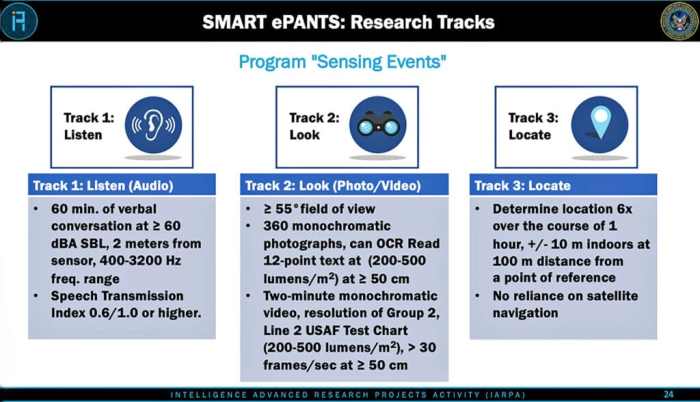(CHD) The U.S. Intelligence Community (IC) recently launched an effort to make computerized clothing a reality — a move critics say could result in massive biometric surveillance of citizens and an increase in people’s exposure to radiofrequency radiation.
The Office of the Director of National Intelligence (ODNI) on Aug. 22 announced that the IC’s advanced research and development arm, Intelligence Advanced Research Projects Activity (IARPA), would develop its computerized clothing program — Smart Electrically Powered and Networked Textile Systems, or SMART ePANTS — over the next three-and-a-half years.
The government’s SMART ePANTS program works to create clothing with “integrated audio, video, and geolocation sensor systems that feature the same stretchability, bendability, washability, and comfort of regular textiles.”
Items slated for production include shirts, pants, socks and underwear.
IARPA, in partnership with the Naval Information Warfare Center, Pacific, awarded research contracts to develop and manufacture the computerized clothing totaling over $22 million to Nautilus Defense and Leidos, Inc., according to an Aug. 9 Pentagon announcement.
SRI International, the Massachusetts Institute of Technology and Areté received undisclosed amounts to develop the technology, according to an article in The Intercept.
Investment giants Vanguard and Black Rock — which benefited from the sale of COVID-19 vaccines and have ownership stakes in technology companies developing vaccine passports and digital wallets — are listed among Nautilus Defense’s and Leidos’ top investors.
SMART ePANTS Program Manager Dawson Cagle, Ph.D., who traced his inspiration for the program to a desire for better health-monitoring options for his diabetic father, said in the recent press release, “IARPA is proud to lead this first-of-its-kind effort for both the IC and broader scientific community which will bring much-needed innovation to the field of ASTs [Active Smart Textiles].”
An article published in January in PubMed hyped the potential of electronic textiles as a “new age of wearable technology for healthcare and fitness solutions,” touting their uses in products as varied as diapers, masks and bedding, and for such applications as “monitoring health conditions, treating chronic diseases, rehabilitation, and improving health and social lifestyles.”
“SMART ePANTS could revolutionize the Internet of Things by collecting data to help intelligence, medical and sports communities,” wrote the Armed Forces Communications and Electronics Association.
But critics — including Ted Claypoole, legal expert and cyberspace law committee chair for the American Bar Association — said IARPA’s program raises major “obvious” privacy concerns.
Claypoole told The Defender that fabrics being developed by the IC are likely “not just for keeping our people safe, but also for finding and following smart-fabric wearers who do not know they are being followed.”
The development of smart fabrics and computer wearables is not a new effort, he said.
In their book, “Privacy in the Age of Big Data: Recognizing Threats, Defending Your Rights, and Protecting Your Family,” Claypoole and Theresa Payton traced commercial efforts to create smart clothing over the past decade, including a ski jacket with earphones in the hood and input devices on the sleeve that connect to the wearer’s phone via bluetooth.
However, the fact that these smart wearables are being designed by the IC is particularly worrisome to Claypoole:
“The technology, when used by the government, opens a new level of intrusion that raises serious Constitutional concerns. Will the government need a warrant to anonymously track people using these fabrics? It should, but that determination will need to be made by courts over time.”
‘I question whether any of this is legal’
W. Scott McCollough — Children’s Health Defense (CHD)’s chief litigator for the organization’s electromagnetic radiation (EMR) cases — shared Claypoole’s concerns.
“While the person choosing to wear the computerized clothing at least has given some kind of consent, all those around that person have no say at all,” McCullough said.
“I question whether any of this is legal,” McCollough added. “The technology will gather biometric data from those nearby, as well as capture all audio and visual data. There are states where all-party consent is required for this.”
Nicole de Haay, an IARPA spokesperson, told The Intercept that IARPA programs are “designed and executed in accordance with, and adhere to, strict civil liberties and privacy protection protocols.”
“IARPA performs civil liberties and privacy protection compliance reviews throughout our research efforts,” she added.


Got myself dressed, ready for the day
tucked in my shirt, heard a voice say
I’m with you, let’s go
I’m the spook in your clothes
I slipped on my jacket, got stabbed in the back
Laced up my shoes, they gave me more flack
Something about my name on list
Something that made me thoroughly pissed
Unbuttoned myself, squirmed outta my duds
Into the bathtub, into the suds
Scrubbing away their all-seeing eye
Down the drain I sent it, forever good-bye
Naked came I into this world
though naked I can’t walk upon it
but no spy-garb made, will ever be laid
on my skin, no treachery worn on it
.